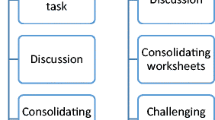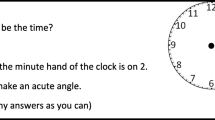Abstract
It remains difficult to foster problem-solving and mathematical-reasoning capabilities in classrooms where students and teachers are accustomed to the more traditional forms of education. Several studies suggest that this difficulty might be related to the kind of knowledge students acquire in such environments, which could be fragmented and superficial. In our research, we developed specific tasks that might improve student’s learning and consequently the kind of knowledge when used in small group work. The learning process we aimed at in this setting is directed at strengthening, grounding and integrating students’ fragmented and pseudo-mathematical knowledge. We called the lessons in this approach—shift-problem lessons—and we investigated the effect of learning arrangements that replace some of the regular lessons with shift-problem lessons. We conducted two quasi-experimental studies: one in geometric proof and another in integral calculus with 16/17-year-old students in pre-university education. Each study involved three experimental classrooms and three comparable classrooms. The results indicate that the learning arrangement seems to have a positive influence on the students’ performance as the experimental group outperformed the control group in particular tasks. We also found that, with regard to small group work in the shift-problem lessons, the groups of students’ success in solving the tasks throughout the course followed different patterns in the integral calculus and geometric-proof courses. These results and the implications of the study for mathematics educators and researchers are discussed.
Similar content being viewed by others
References
Bergqvist, T., Lithner, J. & Sumpter, L. (2008). Upper secondary students’ task reasoning. Journal of Mathematical Education in Science and Technology, 39(1), 1–12.
Cobb, P., Stephan, M., McClain, K. & Gravemeijer, K. (2001). Participating in classroom mathematical practices. Journal of the Learning Sciences, 10(1), 113–163.
Dekker, R., & Elshout-Mohr, M. (1998). A process model for interaction and mathematical level raising. Educational Studies in Mathematics, 35(3), 303–314.
Dekker, R., & Elshout-Mohr, M. (2004). Teacher interventions aimed at mathematical level raising during collaborative learning. Educational Studies in Mathematics, 56(1), 39–65.
Duval, R. (2006). A cognitive analysis of problems of comprehension in learning of mathematics. Educational Studies in Mathematics, 61(1), 103–131.
Fischbein, E. (1993). The theory of figural concepts. Educational Studies in Mathematics, 24(2), 139–162.
Gray, E. & Tall, D. (1994). Duality, ambiguity, and flexibility: A “proceptual” view of simple arithmetic. Journal for Research in Mathematics Education, 25(2), 116–140.
Harel, G. & Sowder, L. (2007). Toward comprehensive perspectives on the learning and teaching of proof. In F. K. Lester (Ed.), Second handbook of research on mathematics teaching and learning (pp. 805–842). Greenwich, CT: Information Age Publishing.
Jones, K. (2000). Providing a foundation for deductive reasoning: Students’ interpretations when using dynamic geometry software and their evolving mathematical explanations. Educational Studies in Mathematics, 44(1), 55–85.
Laborde, C. (2004). The hidden role of diagrams in students’ construction of meaning in geometry. In J. Kilpatrick, C. Hoyles & O. Skovsmose (Eds.), Meaning in mathematics education (pp. 159–180). Dordrecht, The Netherlands: Kluwer.
Lithner, J. (2004). Mathematical reasoning in calculus textbook exercises. The Journal of Mathematical Behavior, 23(4), 405–427.
Lithner, J. (2008). A research framework for creative and imitative reasoning. Educational Studies in Mathematics, 67(3), 255–276.
Mariotti, M. A. (2006). Proof and proving in mathematics education. In A. Gutiérrez & P. Boero (Eds.), Handbook of research on the psychology of mathematics education: Past, present and future (pp. 173–204). Rotterdam: Sense.
Mayer, R. E. (2002). Rote versus meaningful learning. Theory Into Practice, 41(4), 226–232.
Mullins, I. V., Martin, M. O., Gonzalez, E. J., Gregory, K. D., Garden, R. A., O’Conner, K. M., Chrostowski, S. J. & Smith, T. A. (2000). TIMMS 1999 international mathematics report. Findings of the IEA’s repeat of the third International mathematics and science study at the eighth grade. Chestnut Hill, MA: Boston College.
Oehrtman, M. C., Carlson, M. P. & Thompson, P. W. (2008). Foundational reasoning abilities that promote coherence in students’ understandings of function. In M. P. C. C. Rasmussen (Ed.), Making the connection: Research and practice in undergraduate mathematics (pp. 27–42). Washington, DC: Mathematical Association of America.
Palha, S., Dekker, R., Gravemeijer, G., & Van Hout-Wolters, B., (2013). Developing shift problems to foster geometrical proof and understanding. Journal of Mathematical Behaviour, 32(2), 142–159.
Pijls, M. & Dekker, R. (2011). Students discussing their mathematical ideas: The role of the teacher. Mathematics Education Research Journal, 23(4), 379–396.
Pijls, M., Dekker, R. & Van Hout-Wolters, B. (2007). Teacher help for conceptual level raising in mathematics. Learning Environments Research, 10(3), 223–240.
Raman, M. (2003). Key ideas: What are they and how can they help us understand how people view proof? Educational Studies in Mathematics, 52(3), 319–325.
Roorda, G. (2012). Ontwikkeling in verandering: ontwikkeling van wiskundige bekwaamheid van leerlingen met betrekking tot het concept afgeleide. Rijksuniversiteit Groningen.
Schoenfeld, A.H. (1985). Mathematical problem solving. FL, Orlando: Academic Press.
Schoenfeld, A. H. (1992). Learning to think mathematically: Problem solving, metacognition, and sense making in mathematics. In D. A. Grouws (Ed.), Handbook of research on mathematics teaching and learning (pp. 334–371). New York: Macmillan.
Selden, A. & Selden, J. (2003). Validations of proofs considered as texts: Can undergraduates tell whether an argument proves a theorem? Journal for Research in Mathematics Education, 34(1), 4–36.
Sfard, A. (1991). On the dual nature of mathematical conceptions: Reflections on processes and objects as different sides of the same coin. Educational Studies in Mathematics, 22(1), 1–36.
Slavin, R., Lake, C. & Groff, C. (2009). Effective programs in middle and high school mathematics. Review of Educational Research, 79(2), 839–911.
Slavit, D. (1997). An alternate route to the reification of function. Educational Studies in Mathematics, 33(3), 259–281.
Smith, M. (2000). Balancing old and new: Middle school teacher’s learning in the context of mathematics instructional reform. Elementary School Journal, 100(4), 351–375.
Snijders, T. A. B., & Bosker, R. J. (1999). Multilevel analysis: An introduction to basic and advanced multilevel modelling. London: Sage.
Stein, M. K., Grover, B. W. & Henningsen, M. (1996). Building student capacity for mathematical thinking and reasoning: An analysis of mathematical tasks used in reform classrooms. American Educational Research Journal, 33(2), 455–488.
Stein, M. K., Remillard, J. & Smith, M. S. (2007). How curriculum influences student learning. In F. K. Lester (Ed.), Second handbook of research on mathematics teaching and learning (pp. 319–370). Greenwich, CT: Information Age Publishing.
Stigler, J. & Hiebert, J. (2004). Improving mathematics teaching. Educational Leadership, 5(61), 12–16.
Thompson, P. W., & Silverman, J. (2008). The concept of accumulation in calculus. In M.P. Carlson & C. Rasmussen (Eds.), Making the connection: Research and teaching in undergraduate mathematics (pp. 43–52). Washington, DC: Mathematical Association of America.
Van Hiele, P. M. (1986). Structure and insight. Orlando: Academic.
Vinner, S. (1983). Concept definition, concept image and the notion of function. International Journal of Mathematical Education in Science and Technology, 14(3), 293–305.
Watson, A. (2008). How secondary teachers structure the subject matter of mathematics. Proceedings of the British Society for Research into Learning Mathematics, 28(3), 126–131.
Webb, N. M. (2009). The teacher’s role in promoting collaborative dialogue in the classroom. British Journal of Educational Psychology, 79, 1–28.
Yerushalmy, M. & Swidan, O. (2012). Signifying the accumulation graph in a dynamic multi-representation environment. Educational Studies in Mathematics, 80(3), 287–306.
Author information
Authors and Affiliations
Corresponding author
Rights and permissions
About this article
Cite this article
Palha, S., Dekker, R. & Gravemeijer, K. THE EFFECT OF SHIFT-PROBLEM LESSONS IN THE MATHEMATICS CLASSROOM. Int J of Sci and Math Educ 13, 1589–1623 (2015). https://doi.org/10.1007/s10763-014-9543-z
Received:
Accepted:
Published:
Issue Date:
DOI: https://doi.org/10.1007/s10763-014-9543-z




